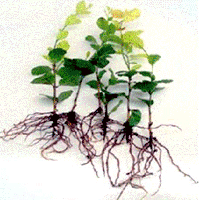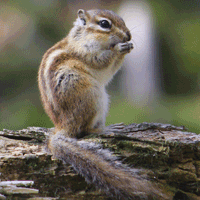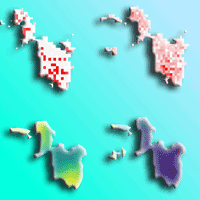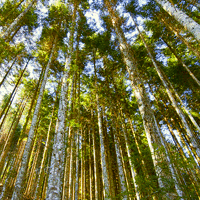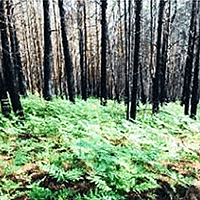
Moderate wildfire severity favors seed removal by granivores in a Mexican pine forest
Daniel A Cadena-Zamudio (1) , Jorge Cadena-Iñiguez (2), Juan F Aguirre-Medina (3), Jorge D Cadena-Zamudio (4), José L Arispe-Vázquez (5), Luis A Barrera-Guzmán (6), Sergio Ayvar-Serna (7), José F Díaz-Nájera (7)
iForest - Biogeosciences and Forestry, Volume 18, Issue 3, Pages 121-127 (2025)
doi: https://doi.org/10.3832/ifor4741-018
Published: May 24, 2025 - Copyright © 2025 SISEF
Research Articles
Abstract
Wildfires are critical to the ecological dynamics of communities in temperate forests. However, their frequency and severity have increased significantly in recent decades due to human activities, negatively affecting flora, fauna, and ecosystem processes. Among the primary interactions for the natural regeneration of forests is seed removal, which promotes secondary seed dispersal and predation. This study evaluated artificial seed removal under different wildfire severities in a pine forest on the eastern edge of the Trans-Mexican Volcanic Belt. An experiment of differential exclusion of vertebrates and invertebrates was carried out, considering two treatments: totally exposed seeds and seeds with exclusion of vertebrates in the unburnt forest, moderate and high severity fire. Our results showed a higher seed removal by vertebrates (birds and rodents) in the wildfire moderate severity treatment and in the time elapsed since wildfire occurrence; however, excluding vertebrates decreased the seed removal rate after the fire. Therefore, moderate-severity sites are an important factor in the communities of granivores that influence seed removal patterns in the temperate forest of Veracruz, Mexico. The findings underscore the importance of considering fire severity gradients in forest management strategies, particularly in fire-adapted ecosystems. As climate change alters fire regimes worldwide, understanding how different fire severities affect ecological interactions such as granivory is essential for promoting forest resilience and biodiversity.
Keywords
Artificial Seeds, Exclusion Experiments, Granivores, Natural Regeneration, Pine Forests, Predation
Authors’ Info
Authors’ address
Department of Forest Ecology, Interdisciplinary Research Group at Sechium edule in México (GISeM), Agustín Melgar 10, Texcoco, 56160, México (Mexico)
Department of Botany, Colegio de Postgraduados, Iturbide 73, 78622, San Luis Potosí (Mexico)
Department of Plant Phisiology, Universidad Autónoma de Chiapas, Entronque Carretera Costera y Pueblo de Huehuetán, 30660, Chiapas (Mexico)
Department of Forestry Genetic Resources, Instituto Nacional de Investigaciones Forestales, Agrícolas y Pecuarias, Boulevard de La Biodiversidad 400, 47600, Jalisco (Mexico)
Department of Forestry Management and Agroecology, Instituto Nacional de Investigaciones Forestales, Agrícolas y Pecuarias, Carretera Iguala-Tuxpan, 40000, Guerrero (Mexico)
Department of Sustainable Ecosystems, Universidad Autónoma Chapingo, Carretera Federal Huatusco-Xalapa Km. 6.5, 94100, Veracruz (Mexico)
José F Díaz-Nájera 0000-0001-7181-9425
Department of Forestry Management, Colegio Superior Agropecuario del Estado de Guerrero, 40000, Guerrero (Mexico)
Corresponding author
Paper Info
Citation
Cadena-Zamudio DA, Cadena-Iñiguez J, Aguirre-Medina JF, Cadena-Zamudio JD, Arispe-Vázquez JL, Barrera-Guzmán LA, Ayvar-Serna S, Díaz-Nájera JF (2025). Moderate wildfire severity favors seed removal by granivores in a Mexican pine forest. iForest 18: 121-127. - doi: 10.3832/ifor4741-018
Academic Editor
Marco Borghetti
Paper history
Received: Oct 06, 2024
Accepted: Feb 06, 2025
First online: May 24, 2025
Publication Date: Jun 30, 2025
Publication Time: 3.57 months
Copyright Information
© SISEF - The Italian Society of Silviculture and Forest Ecology 2025
Open Access
This article is distributed under the terms of the Creative Commons Attribution-Non Commercial 4.0 International (https://creativecommons.org/licenses/by-nc/4.0/), which permits unrestricted use, distribution, and reproduction in any medium, provided you give appropriate credit to the original author(s) and the source, provide a link to the Creative Commons license, and indicate if changes were made.
Web Metrics
Breakdown by View Type
Article Usage
Total Article Views: 4100
(from publication date up to now)
Breakdown by View Type
HTML Page Views: 1223
Abstract Page Views: 1284
PDF Downloads: 1443
Citation/Reference Downloads: 0
XML Downloads: 150
Web Metrics
Days since publication: 204
Overall contacts: 4100
Avg. contacts per week: 140.69
Citation Metrics
Article Citations
Article citations are based on data periodically collected from the Clarivate Web of Science web site
(last update: Mar 2025)
(No citations were found up to date. Please come back later)
Publication Metrics
by Dimensions ©
Articles citing this article
List of the papers citing this article based on CrossRef Cited-by.
References
Regímenes de fuego en ecosistemas forestales de México. impacto ambiental de incendios forestales [Fire regimes in forest ecosystems of Mexico. Environmental impact of forest fires]. Instituto Nacional de Investigaciones Forestales Agrícolas y Pecuarias, Colegio de Postgraduados, México, pp. 731 [in Spanish]
Gscholar
Efecto de la vegetación sobre la abundancia y diversidad de depredadores de semillas de Pinus teocote Schl. et Cham. en hábitats contrastantes del estado de Veracruz, México [Effect of vegetation on the abundance and diversity of seed predators of Pinus teocote Schl. et Cham. in contrasting habitats in the state of Veracruz, Mexico]. Msc Thesis, Universidad Veracruzana, Veracruz, México, pp. 64 [in Spanish]
Gscholar
Programa de Manejo de San Juan del Monte [San Juan del Monte Management Program]. Gobierno del Estado de Veracruz - GEV, Coordinación Estatal de Medio Ambiente - CEMA, México DF, pp. 190 [in Spanish]
Gscholar
Granivory. In: “Plant-Animal Interactions: An Evolutionary Approach” (Herrera CM, Pellmyr O eds). Oxford University Press, Oxford, pp. 132-156.
Gscholar
Evaluación de un incendio forestal en un bosque de coníferas del centro de Veracruz: análisis de la sucesión temprana usando percepción remota y métodos a nivel de campo [Evaluation of a forest fire in a coniferous forest in central Veracruz: early succession analysis using remote sensing and field level methods]. Ms Thesis, Instituto de Ecología AC, México, pp. 90 [in Spanish]
Gscholar
Evaluation of seed removal by rodents and ants in Mediterranean pine forests affected by forest fires. Doctoral dissertation, Department of Experimental Sciences and Sustainability, University of Girona, Spain, pp. 119.
Gscholar
Seed bank formation and removal of Pinus hartwegii (Pinaceae) seeds along an altitudinal gradient in the Cofre de Perote National Park, Veracruz, Mexico. Botanical Sciences 97 (4): 623-629.
CrossRef | Gscholar
Areas naturales protegidas de México con decretos estatales [Protected natural areas in Mexico with state decrees]. Secretaría de Medio Ambiente y Recursos Naturales, Instituto Nacional de Ecología y Comisión Nacional de Áreas Naturales Protegidas, México DF, Vol 2, pp. 1022. [in Spanish]
Gscholar
Trait shifts in bird communities from primary forest to human settlements in Mexican seasonal forests. Are there ruderal birds? Perspectives in Ecology and Conservation 20 (2): 117-125.
CrossRef | Gscholar

